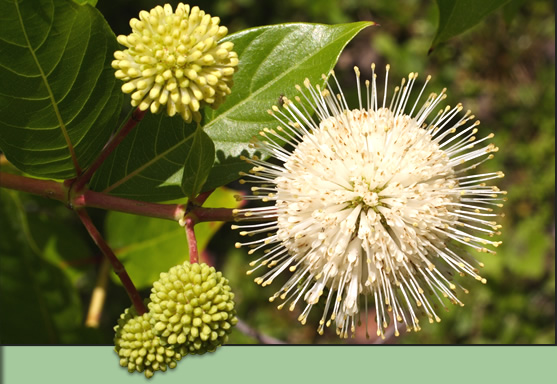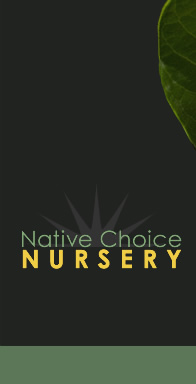
Native Gardening Articles
Browse these informative articles written by Jeff Nurge as seen in the Palm Beach Post.
- Fiddlewood (Citharexylum fruticosum)
- Marlberry (Ardisia escallonioides)
- Red Bay (Persea borbonia)
- Mastic (Sideroxylon foetidissimum)
- Varnish Leaf (Dodonaea viscosa)
Fiddlewood (Citharexylum fruticosum)
Why We Like It

No native yard should be without the Fiddlewood (citharexylum fruticosum). Or any other South Florida yard for that matter. The Fiddlewood is a popular native tree that usually takes a shrub-like appearance. Planted eight feet apart they make a wonderful hedge or property screen that can reach up to 20 feet in height. Whether pruned moderately or severely they quickly sprout new growth. With very glossy green leaves the Fiddlewood always has the appearance as if the leaves are varnished daily. Couple that with tubular, white five petal flowers that are carried in 2 to 4 inch clusters drooping from long leaf axils that bloom from spring to fall this tree puts on quite a show. This time of year the flowers are giving way to slightly smaller marble sized fruits of a remarkable yellow or reddish-black. Between the flowers and the fruits the fiddlewood is a feast for our native bees, butterflies and birds.
How To Grow It
The Fiddlewood can be planted in full sun to light shade in a wide range of soil types and once established is extremely drought tolerant. For best results, full sun is preferred as the canopy of the Fiddlewood will become dense and flower and fruit prolifically. Propagation is by seed. The tree is remarkably hearty and not normally subject to diseases as it matures. However, be on the lookout for moth caterpillars that have been known to make a meal on the leaves. Thankfully they rarely do any lasting damage to the tree. Mature trees were prized years ago for their heavy hard wood that were used in the manufacture of musical instruments. Hence, Fiddlewood.
Where To Buy It
For a list of local nurseries that carry Fiddlewood, visit the Web site of the Florida Association of Native Nurseries.
The Florida Native Plant Society promotes the preservation, conservation, and restoration of the native plants and native plant communities of Florida. The Palm Beach County Chapter (palmbeach.fnpschapters.org) meets on the third Tuesday of the month at 7:30, Mounts Building, UF/IFAS Extension, 531 N. Military Trail, West Palm Beach.
Marlberry (Ardisia escallonioides)
Why We Like It

Marlberry or Marble-Berry is a native plant with many attributes. It is evergreen with darker green leaves above that are a shiny 3 to 6 inches long. Either flowers or fruits are present throughout the year. The flowers range from white to pink peaking in the fall creating a wonderful appearance of freshly deposited mounts of snow. The flowers are followed by black fruits about 1/4 of an inch in diameter which are highly prized by hungry birds. Marlberry is an excellent start or addition to a native yard.
How To Grow It
Marlberry normally grows as a shrub under trees in light to moderate shade however it can be highly adaptive and drought tolerant once established in full sun. It can be maintained with period trimming to form a hedge or left to its own to become a small tree ranging in height from 6 to 15 feet and usually taller than broad. The soil can be poor in nutrients but with some organic material to thrive. Marlberry propagates itself by seed usually underneath the parent plant.
Where To Buy It
If you are interested in finding native plants, visit the Association of Florida Association of Native Nurseries, but don't stop there. The site provides only a snapshot of the offerings at local nurseries, so call around.
The Florida Native Plant Society promotes the preservation, conservation and restoration of the native plants and native plant communities of Florida. The Palm Beach County Chapter (palmbeach.fnpschapters.org) meets at 7:30 p.m. on the third Tuesday of the month, Mounts Building, UF/IFAS Extension, 531 N. Military Trail, West Palm Beach.
Red Bay (Persea borbonia)
Why We Like It

The Red Bay is a versatile addition to your native yard. This single or muti-trunked tree standing from 20-40 ft tall with a habit of tilting in one direction or another adds interest to your landscape. Red Bay has a thick rough bark that has many ridges running through it. Heavily branched with dark green leaves that when crushed smell like the bay leaf we are accustomed to spicing up our food dishes. The tree flowers in the spring with inconspicuous blooms that our native bees find irresistible. The flowers give way to dark blue berries that are gobbled up quickly by birds. If that is not enough wildlife for you, the Red Bay is also the larval host for the palamedes swallowtail butterfly. As with some of our native trees the Red Bay is susceptible to a tiny gall-forming insect that deforms some of the leaves. But not to worry, this does not hurt the tree in the slightest and is considered a sign of a healthy tree.
How To Grow It
The Red Bay has a moderate growth rate and is best in moist but well drained soils. It can grow in nutrient poor soils but some organic material is needed for it to thrive. Full sun to light shade is preferred and when established is highly drought tolerant.
Where To Buy It
If you are interested in finding native plants, visit the Association of Florida Association of Native Nurseries, but don't stop there. The site provides only a snapshot of the offerings at local nurseries, so call around.
The Florida Native Plant Society promotes the preservation, conservation and restoration of the native plants and native plant communities of Florida. The Palm Beach County Chapter (palmbeach.fnpschapters.org) meets at 7:30 p.m. on the third Tuesday of the month, Mounts Building, UF/IFAS Extension, 531 N. Military Trail, West Palm Beach.
Mastic (Sideroxylon foetidissimum)
Why We Like It

The Mastic, only found in Florida in the United States, is one of our large native trees growing to 50 to 60 feet tall on average. The Florida state champ is 118 feet tall! It is much taller than broader with an irregular but rounded crown. The evergreen leaves are shiny and range from dark green to yellowish-green. The mastic flowers are inconspicuous but soon give way to yellow-orange berries that are about 1 inch long. The fruits attract a wide variety of birds and wildlife. The tree is nearly pest free except for the occasional occurrence of the gall insect. This does not hurt the tree and is quite frankly a sign of a healthy tree.
How To Grow It
Don't start this tree out in partial shade. The Mastic loves full sun and lots of it. It grows naturally in tropical hardwood hammocks where it is an important canopy tree. Once established it is highly drought tolerant and does not need any supplemental watering. The tree will thrive in a wide variety of soils provided it is in an area that drains well. Growth rate is moderate. Plant in an open area where shade is desired and away from driveways, decks and walkways as the falling berries will leave a mess. Propagation is by seed.
Where To Buy It
If you are interested in finding native plants, visit the Association of Florida Association of Native Nurseries, but don't stop there. The site provides only a snapshot of the offerings at local nurseries, so call around.
The Florida Native Plant Society promotes the preservation, conservation and restoration of the native plants and native plant communities of Florida. The Palm Beach County Chapter (palmbeach.fnpschapters.org) meets at 7:30 p.m. on the third Tuesday of the month, Mounts Building, UF/IFAS Extension, 531 N. Military Trail, West Palm Beach.
Varnish Leaf (Dodonaea viscosa)
Why We Like It

Varnish Leaf is one of our native plants that grow in tropic and subtropic coastal thickets throughout the world. This tough evergreen bush grows up to 15 feet in height in idea conditions. If grown in full sun and dry soil it will limit itself from 3 to 4 feet in height. The 3 to 6 inch long very glossy leaves are a yellowish-green with a slightly sticky resin. The flowers are scarcely noticed but are followed up by three winged capsules that are sometimes a deep red color.
How To Grow It
Plant in a sunny spot. Drought tolerance is high for the varnish leaf after it has been established. It can be grown in moist well-drained sandy soils with very little organic material. If you are close to the coast the varnish leaf also has a high tolerance to salt wind spray. Propagation is by seed.
Where To Buy It
If you are interested in finding native plants, visit the Association of Florida Association of Native Nurseries, but don't stop there. The site provides only a snapshot of the offerings at local nurseries, so call around.
The Florida Native Plant Society promotes the preservation, conservation and restoration of the native plants and native plant communities of Florida. The Palm Beach County Chapter (palmbeach.fnpschapters.org) meets at 7:30 p.m. on the third Tuesday of the month, Mounts Building, UF/IFAS Extension, 531 N. Military Trail, West Palm Beach.


